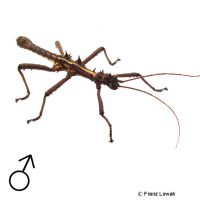Thorny Stick Insect (Aretaon asperrimus)
| Thorny Stick Insect Aretaon asperrimus | |
|---|---|
| Name | Thorny Stick Insect |
| Name Lat. | Aretaon asperrimus |
| Family | Heteropterygids |
| Family lat. | Heteropterygidae |
| Order | Phasmids |
| Order lat. | Phasmatodea |
| Origin | Borneo |
| Habitat | Rainforest |
| Diet | Fresh rose-family leaves |
| Humidity | 70-90 % |
| Behavior | Nocturnal, peaceful |
| Keeping | Individual, pair, group |
| Care Level | Easy |
| Housing | Humid terrarium |
| Breeding | Simple |
| Life Span | 6 months |
| Protection | No |
| Metric Units | |
| Size | 5-9 cm |
| Temperature Day | 22-25 °C |
| Temperature Night | 18-22 °C |
| Housing Size | 40 x 40 x 60 cm |
| US Units | |
| Size | 2"-3.5" |
| Temperature Day | 72-77 °F |
| Temperature Night | 64-72 °F |
| Housing Size | 15" x 15" x 25" |
Distribution and habitat
The crepuscular to nocturnal thorny ghost insects are native to northern Borneo and Labuan Island. There, the wingless animals live on low trees and shrubs of the tropical rainforests.
Maintenance
A terrarium of 40 x 40 x 60 cm (L x W x H) for one animal or a small group is recommended. A terrarium with a cover made of gauze or fine metal mesh is best. The terrarium should be placed in a quiet place without sunlight
They need climbing opportunities, such as cork back walls, twigs and branches, which also serve as food plants. In order to keep them fresh for a longer time, they should be served in narrow-necked, well-sealed (danger of drowning), stable containers (e.g. vase). Suitable substrate is terrarium humus or a soil-sand mixture covered with moss, which should always be kept slightly moist. Once a day, preferably in the evening, the insectarium should be finely sprayed with water inside (humidity), but a rain or mist system is better. Waterlogging should be avoided at all costs. Good ventilation is especially important
| Temp. day: 22-25 °C | Temp. night: 18-22 °C | Humidity: 70-90 |
Although the animals are nocturnal, a light source that also produces the necessary heat is ideal. The lighting duration should be 8-12 hours, depending on the season
Diet
The food supply consists of fresh leaves of blackberry, honeysuckle (Lonicera nitida), laburnum, elderberry and ivy (Hedera helix), as well as leaves of ferns. Leaves of other roses and rose plants, such as red and hawthorn, raspberry, currant, wild rose, etc., as well as the leaves of beech, oak, linden, hazel, eucalyptus or sweet chestnut are also accepted differently by individuals. Blackberries are ideal as food in winter, as they remain green. Spraying the forage plants allows the animals to satisfy their drinking needs. Additionally, a wick waterer is recommended. Eaten branches, dried and rotten leaves must be removed regularly
A regular and varied diet promotes the well-being of the animals.
Reproduction and breeding
Both sexes are variably colored in different shades of brown and have many spines. The smaller males show bright yellowish stripes on the back. The females have a clearly recognizable laying apparatus
The females pierce the eggs individually into the substrate with their ovipositor. The incubation period is several months at about 20-25 °C. The newly hatched juveniles have many more spines than adults for protection from predators. After the last moult (imaginal moult) the animals live for about 6 months
Important
The spiny ghost insects have produced very light to light beige color varieties in addition to the various brown colored ones.
Before purchasing, a terrarium should be prepared that meets the species-specific needs. Necessary are good ventilation without drafts and equipment for measuring temperature and humidity. The lighting has to correspond to the species-specific day-night rhythm and should be placed in such a way that the animals cannot injure themselves
The terrarium should be locked in such a way that neither unauthorized persons can open it nor the animals can escape. Special attention must be paid to thorough hygiene and impurities must be removed regularly
Further literature can be found in your pet store
References
Text: petdata; Image: Franz Lowak
Source: SEILER, BRADLER, KOCH (2000): Ratgeber Phasmiden, Verlag Bede; ENGELMANN & LANGE (2011): Zootierhaltung - Tiere in menschlicher Obhut: Wirbellose, Harri Deutsch Verlag
